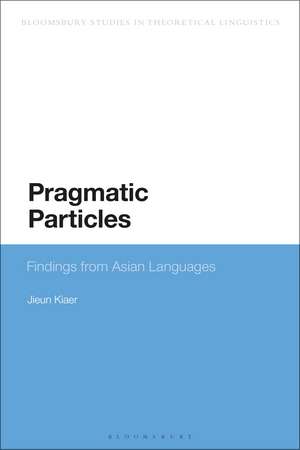Pragmatic Particles: Findings from Asian Languages: Bloomsbury Studies in Theoretical Linguistics
Autor Jieun Kiaeren Limba Engleză Paperback – 18 mai 2022
| Toate formatele și edițiile | Preț | Express |
|---|---|---|
| Paperback (1) | 198.22 lei 6-8 săpt. | |
| Bloomsbury Publishing – 18 mai 2022 | 198.22 lei 6-8 săpt. | |
| Hardback (1) | 715.58 lei 6-8 săpt. | |
| Bloomsbury Publishing – 25 noi 2020 | 715.58 lei 6-8 săpt. |
Preț: 198.22 lei
Preț vechi: 258.12 lei
-23% Nou
Puncte Express: 297
Preț estimativ în valută:
37.93€ • 39.71$ • 31.38£
37.93€ • 39.71$ • 31.38£
Carte tipărită la comandă
Livrare economică 05-19 aprilie
Preluare comenzi: 021 569.72.76
Specificații
ISBN-13: 9781350191655
ISBN-10: 1350191655
Pagini: 256
Dimensiuni: 156 x 234 mm
Greutate: 0.36 kg
Editura: Bloomsbury Publishing
Colecția Bloomsbury Academic
Seria Bloomsbury Studies in Theoretical Linguistics
Locul publicării:London, United Kingdom
ISBN-10: 1350191655
Pagini: 256
Dimensiuni: 156 x 234 mm
Greutate: 0.36 kg
Editura: Bloomsbury Publishing
Colecția Bloomsbury Academic
Seria Bloomsbury Studies in Theoretical Linguistics
Locul publicării:London, United Kingdom
Caracteristici
Discussion is based on SOV, agglutinative languages from Asia, which have been less-widely studied within theoretical linguistics
Notă biografică
Jieun Kiaer is Professor in Korean Language and Linguistics at the University of Oxford, UK.
Cuprins
Preface1. Introduction2. Modelling Flexible Word Orders3. Efficiency Grammar4. Multi-Dimensional Meanings5. Socio-Pragmatic Meanings6. Particles as a Meaning Complex7. Pragmatic Syntax8. Constructive Particles and Syntactic Fluidity9. Expressive Particles and Socio-Pragmatic ComplexityEpilogueNotesBibliographyIndex
Recenzii
An inspirational book which is informative and practical. Through an easily accessible approach to the subject, this book gives new insights to readers who have a keen interest in the socio-pragmatic elements of language and linguistic theories beyond the Anglo-centric discussion.
[T]his book makes a significant contribution to the study of particles in Asian languages and further to theoretical linguistics in general. It adopts a comprehensive approach encompassing formal and functional theories of grammar, and effectively deals with the multidimensionality of meaning that cannot be addressed in a streamlined way otherwise. Researchers at various levels and persuasions will benefit from reading it.
This book offers invaluable insights into the development of a formal framework for investigating pragmatic particles, by using examples from a number of Asian languages. The words in the book title ring true as data from various Asian language families are presented.
This book enables learners, researchers and teachers of languages to understand the formal and functional foundations of Asian languages - in a sensible and holistic way. It bridges the gap between formal and functional, theoretical and empirical approaches to language. I highly recommend this book to those who are interested in linguistic theory beyond the Anglo-centric discussion.
This book makes a significant and important contribution both to theoretical linguistics and the study of particles in Asian languages. Using data from across languages of Asia from the Middle to the Far East, Kiaer puts forward cogent and compelling arguments that such languages should have a greater influence on the developments of theories of language and not be analysed in terms of euro-centric views of grammar. She further argues that socio-pragmatic properties of these particles are central to explaining their syntactic and other grammatical behaviour.
Pragmatic Particles timely brings to the forefront of discussion the multidimensionality of Asian languages within the realm of contemporary linguistics. By challenging verb-centric, sentence-bound analyses which permeate the prevailing Euro-centric views on linguistic theory and application, this book offers both theoretical and empirical insight into researching Asian languages. It takes an accessible approach to the subject and encourages readers to re-evaluate the treatment of linguistic data, while critically guiding them through this process. Whether you have a budding curiosity for linguistic theory or a deep interest in the socio-pragmatic elements of language, I highly recommend you to read this book.
[T]his book makes a significant contribution to the study of particles in Asian languages and further to theoretical linguistics in general. It adopts a comprehensive approach encompassing formal and functional theories of grammar, and effectively deals with the multidimensionality of meaning that cannot be addressed in a streamlined way otherwise. Researchers at various levels and persuasions will benefit from reading it.
This book offers invaluable insights into the development of a formal framework for investigating pragmatic particles, by using examples from a number of Asian languages. The words in the book title ring true as data from various Asian language families are presented.
This book enables learners, researchers and teachers of languages to understand the formal and functional foundations of Asian languages - in a sensible and holistic way. It bridges the gap between formal and functional, theoretical and empirical approaches to language. I highly recommend this book to those who are interested in linguistic theory beyond the Anglo-centric discussion.
This book makes a significant and important contribution both to theoretical linguistics and the study of particles in Asian languages. Using data from across languages of Asia from the Middle to the Far East, Kiaer puts forward cogent and compelling arguments that such languages should have a greater influence on the developments of theories of language and not be analysed in terms of euro-centric views of grammar. She further argues that socio-pragmatic properties of these particles are central to explaining their syntactic and other grammatical behaviour.
Pragmatic Particles timely brings to the forefront of discussion the multidimensionality of Asian languages within the realm of contemporary linguistics. By challenging verb-centric, sentence-bound analyses which permeate the prevailing Euro-centric views on linguistic theory and application, this book offers both theoretical and empirical insight into researching Asian languages. It takes an accessible approach to the subject and encourages readers to re-evaluate the treatment of linguistic data, while critically guiding them through this process. Whether you have a budding curiosity for linguistic theory or a deep interest in the socio-pragmatic elements of language, I highly recommend you to read this book.








